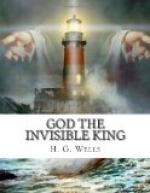His matter is modern religion as he sees it. It is only incidentally and because it is unavoidable that he attacks doctrinal Christianity.
In a previous book, “First and Last Things” (Constable and Co.), he has stated his convictions upon certain general ideas of life and thought as clearly as he could. All of philosophy, all of metaphysics that is, seems to him to be a discussion of the relations of class and individual. The antagonism of the Nominalist and the Realist, the opposition of the One and the Many, the contrast of the Ideal and the Actual, all these oppositions express a certain structural and essential duality in the activity of the human mind. From an imperfect recognition of that duality ensue great masses of misconception. That was the substance of “First and Last Things.” In this present book there is no further attack on philosophical or metaphysical questions. Here we work at a less fundamental level and deal with religious feeling and religious ideas. But just as the writer was inclined to attribute a whole world of disputation and inexactitudes to confused thinking about the exact value of classes and terms, so here he is disposed to think that interminable controversies and conflicts arise out of a confusion of intention due to a double meaning of the word “God”; that the word “God” conveys not one idea or set of ideas, but several essentially different ideas, incompatible one with another, and falling mainly into one or other of two divergent groups; and that people slip carelessly from one to the other of these groups of ideas and so get into ultimately inextricable confusions.
The writer believes that the centuries of fluid religious thought that preceded the violent ultimate crystallisation of Nicaea, was essentially a struggle—obscured, of course, by many complexities—to reconcile and get into a relationship these two separate main series of God-ideas.
Putting the leading idea of this book very roughly, these two antagonistic typical conceptions of God may be best contrasted by speaking of one of them as God-as-Nature or the Creator, and of the other as God-as-Christ or the Redeemer. One is the great Outward God; the other is the Inmost God. The first idea was perhaps developed most highly and completely in the God of Spinoza. It is a conception of God tending to pantheism, to an idea of a comprehensive God as ruling with justice rather than affection, to a conception of aloofness and awestriking worshipfulness. The second idea, which is opposed to this idea of an absolute God, is the God of the human heart. The writer would suggest that the great outline of the theological struggles of that phase of civilisation and world unity which produced Christianity, was a persistent but unsuccessful attempt to get these two different ideas of God into one focus. It was an attempt to make the God of Nature accessible and the God of the Heart invincible, to bring the former into a conception of love and to vest the latter with




